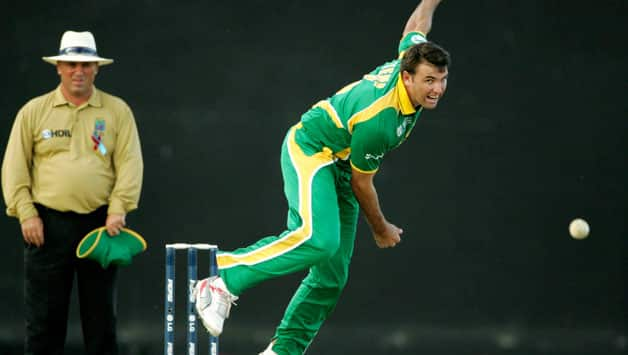
Prakash Govindasreenivasan
(Prakash Govindasreenivasan is a reporter with cricketcountry.com. His twitter handle is @PrakashG_89)
Written by Prakash Govindasreenivasan
Published: Oct 02, 2013, 06:16 PM (IST)
Edited: Aug 20, 2014, 12:56 AM (IST)


Justin Kemp © Getty Images
Born on October 2, 1977, Justin Kemp is a tall, well-built all-rounder from South Africa who began his career when another famed all-rounder Lance Klusener was approaching the end of his. For more reasons than one, Kemp was looked at as Klusener’s heir apparent as the former had the ability to clear the field with ease and help his side prevail in tight situations. However, Kemp’s career did not last very long. Prakash Govindasreenivasan has more.
If Justin Miles Kemp did not have his cricketing gear on, most onlookers would never guess he was a cricketer. With broad shoulders and a towering height, Kemp probably came across as a key member of a side in a semi-contact sport — a quarter back (American football) or central defender (football) maybe. Yet, ‘Kempie’ had strong cricketing roots. His grandfather and father had both played a bit of domestic cricket while his cousin represented South Africa in a handful of One-Day Internationals (ODI).
Test debut
Kemp had a dream start in his Test debut against Sri Lanka at the Centurion in 2001. He finished with match figures of five for 52. Two wickets came in the first innings which helped South Africa wrap up the visitors’ innings for 119 while the next three came in the second essay where Sri Lanka were struggling and Kemp struck to deflate their fading hopes by dismissing the tail-enders. South Africa went on to win the game by an innings and seven runs.
A month later, Kemp set the domestic circuit alight with his powerful display of batting. While playing for Eastern Province against North West, Kemp smashed 188. His knock included nine sixes, five of which came in a single over.
The ill-fated West Indies tour
South Africa went on to beat West Indies in their own backyard in a Test series in 2001 but the controversy surrounding a few of their players smoking marijuana in celebration ruined their win. Kemp, who had not had too much of a role to play on the field, was one of the few who were caught and reprimanded.
Later in the same year, Kemp finished with his career-best figures of three for 20 in ODIs against India in Durban. This performance with the ball came in the final of a triangular series involving India, South Africa and Kenya. After Shaun Pollock won the toss and put India in to bat, Rahul Dravid was on course to take his side to a big total. Kemp, however, had other plans as he dismissed him for a well-made 77. Kemp also got the crucial wicket of Yuvraj Singh and wrapped up the Indian innings by dismissing Anil Kumble. His figures of three for 20 helped South Africa clinch the tri-series.
Till this point in his career, Kemp was hardly used as a batsman. The selectors had seen Kemp only as a utility bowler, despite his strength and ability to clear the ground and add crucial runs coming down the order.
Kemp’s poor form with the bat carried on till 2002 after which he was dropped from the side. In a bid to get back into the national side, Kemp went on to ply his trade in the English County for Worcestershire in the following year.
In a game against Glamorgan, Kemp finished with figures of five for 48 and followed it up with a fast-paced 90 against Hampshire to prove that he was far from done.
After being out of contention for three years, the South African selectors picked him for the home series against England. Thus began what he can fondly look back at as the purplest patch of his career.

Justin Kemp scored 1,512 runs in ODI cricket at an average of 31.50 © Getty Images
Kemp sealed and delivered a series win for his side over England with splendid performances with the bat in the fifth and sixth ODIs. England had won the first game of the seven-match series while the second ended in a tie followed by a win for the home side. The fourth game of the series was crucial to set the tone for the rest of the series and Kemp’s powerful display of batting helped the hosts go 2-1 up in the series. Kemp and Herschelle Gibbs added 143 runs for the third wicket, with Kemp slamming 57 off 36 deliveries. His innings included four fours and four sixes and was vital in taking his side to a total of 291. In the following game, he shifted to the next gear as he struck a 50-ball 80 to take his side’s total past 300. Here, he was involved in a 117-run stand with Graeme Smith for the fifth wicket. With these two performances, Kemp managed to change the perception of the selectors that he was only a handy bowler.
Thanks to these performances, Kemp found himself in the side for the home series against Zimbabwe wherein he played another blinder-of-an-innings at No 7. He slammed five sixes against the listless Zimbabwe bowling attack to finish with 53 not out from just 21 deliveries in the second ODI. He followed it up with a vital knock of 78 not out from 81 deliveries in the third ODI to help his side chase a low total after an initial collapse in the batting-order.
He then travelled to West Indies and kept his consistency with the bat going. In a series that was dominated by the visitors, Kemp added another half-century to his name in the fourth ODI. Towards the end of 2005, Kemp proved that he was more than just a powerful hitter of the ball and that he could survive crunch situations and take his side through. Playing against New Zealand at Bloemfontein, Kemp was the chief architect of his side’s narrow two-wicket win over the visitors. Chasing 250, the hosts lost wickets at regular intervals and were reduced to 117 for five at one stage. However, two important partnerships of 65 runs each — with Mark Boucher for the sixth wicket and Pollock for the seventh wicket — kept the hosts alive. Kemp finished with 73 from 64 deliveries and his side was through with three balls to spare.
His consistent performances with the bat earned him a ticket to India for the ICC Champions Trophy 2006. In South Africa’s 124-run victory over Pakistan at Mohali, Kemp scored another half-century down the order. He and Boucher came together once again, this time to add 133 runs for the sixth wicket.
Century against India
Kemp had been consistently scoring half-centuries but having to play at lower positions in the batting-order, the triple figures eluded him. However, even that came along when India toured South Africa in 2006. It did not come in the best of situations. Despite winning the toss and electing to bat first, South Africa were in the dumps as the Indian bowlers reduced them to 76 for six. The onus of rescuing the hosts was on the broad shoulders of Kemp and he delivered. First, he added a cautious 60-run stand with Pollock for the seventh wicket. Pollock was dismissed in the 36th over with the score on 136. Andrew Hall walked out and what followed was absolute carnage. Hall and Kemp went about thrashing the Indian bowling and added an unbeaten stand of 138 from just 85 deliveries for the eighth wicket. Kemp finished exactly on 100 not out from 89 deliveries, an essay laced with six fours and seven sixes. A target of 275 proved to be too much for the visitors as they folded for 168, giving South Africa a 106-run victory.
However, Kemp failed to live up to the promise he showed during this period and his waning form did not merit him a place in the side too often. Kemp played for Africa XI in the Afro-Asia Cup and scored 86 off 76 deliveries in a losing cause in 2007. After Mahendra Singh Dhoni (139 from 97 balls) and Mahela Jayawardene (107 from 106 balls) entertained the crowd during Asia XI’s batting, Kemp did the same with seven sixes during his innings. Though Africa XI lost, it was a closely-contested high-scoring game that thrilled the crowd to bits.

Justin Kemp was a handy bowler in ODI cricket and he picked up 32 wickets at an average of 31.71 © Getty Images
He was picked for the ICC World Cup 2007 but indifferent performances put him out of contention for the T20 World Cup. By this time, opportunities at the international level were hard to come by and Kemp decided to join the Indian Cricket League (ICL) in 2008. This brought an end to his international career. He represented the Hyderabad Heroes.
After cutting off his ties with ICL, Kemp was picked up by the Chennai Super Kings in the Indian Premier League (IPL) player auctions in 2010.
Kemp finished his international career with 85 ODIs to his name in which he scored 1,512 runs at an average of 31.50. He also picked up 32 wickets. In the four Tests that he played, Kemp scored 80 runs and picked up nine wickets.
Kemp had all the ingredients to be a successful all-rounder for a longer period of time for South Africa but their failure to utlise him and extract maximum from his potential brought an early end to his international career. On his best days, Kemp could have matched Klusener as an asset in the side.
(Prakash Govindasreenivasan is a reporter with CricketCountry. His Twitter handle is @PrakashG_89)
This website uses cookies so that we can provide you with the best user experience possible. Cookie information is stored in your browser and performs functions such as recognising you when you return to our website and helping our team to understand which sections of the website you find most interesting and useful.
Strictly Necessary Cookie should be enabled at all times so that we can save your preferences for cookie settings.
If you disable this cookie, we will not be able to save your preferences. This means that every time you visit this website you will need to enable or disable cookies again.
